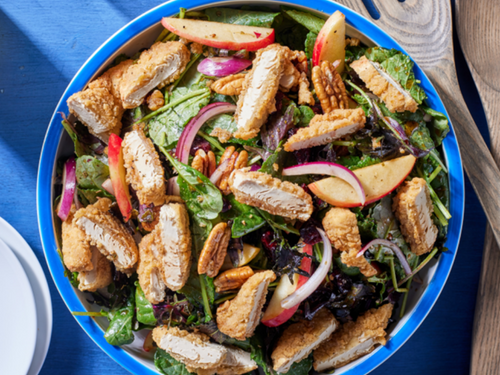WE HAVE THE INGREDIENTS FOR SUCCESS.
Building Your Bridge to Promoting Your Plant-based Offerings
Plant based foods aren’t just for vegans and vegetarians anymore. Such offerings have seen explosive growth on menus in recent years. When it comes to selling plant-based foods on your menu, Affinity Group is here to help you remember that sales success depends not only on what you’re offering but how you say you’re offering it. Check out our insights into the do’s and don’ts of marketing your plant based offerings.
| FOCUS ON FLAVOR Using descriptive language to spotlight how a dish tastes is an easy way to increase its appeal and get more orders. Names that highlight the delicious, distinctive flavors in a particular dish are particularly effective in increasing sales. For example, A 2018 Stanford study supports the idea that highlighting flavor increases sales of plant-rich dishes. Flavor-focused names such as “Rich buttery roasted sweet corn” and “Zesty ginger turmeric sweet potatoes” were chosen by diners 41% more often over identically prepared vegetables with healthy restrictive labels and 25% more often than those with basic labels. |
| EMPHASIZE LOOK AND FEEL The name of your dishes should highlight the qualities that make it delicious and distinctive. Color is a great way to set their expectations of what a food will taste like. For example, “Rainbow salad” creates an expectation of a fresh, flavor-packed and visually vibrant dish. Mouthfeel matters, too. Using language such as ‘melt in the mouth’ which is associated with high-fat food can help overcome preconceived notions that plant-rich food is boring, bland and not tasty. Consider using terminology such as creamy, warming, crunchy, smooth and sticky to communicate mouthfeel. |
| OFFER ORIGIN STORIES In a time when more and more consumers want to know where their food comes from, labels that call out ingredients’ origin are a great way to increase sales. For example, a Panera Bread in Los Angeles decided to change the name of one of its soups to call out its provenance, resulting in a bump in orders. The restaurant switched the name of its “low-fat vegetarian black bean soup” to “Cuban black bean soup” in a month-long naming test in January 2018. The swap led to a 13% uplift in sales. By showcasing the dish’s origin, the dish became instantly more appealing to guests. |
| USE COMMONPLACE PROMOTION PLACEMENT Show plant-based dishes alongside animal-based items to demonstrate similarity and set expectations that they will fill the same wants and needs. Just like other menu items, plant-based foods benefit from good marketing and intentional advertising. Use images and videos that highlight flavor and familiarity. |
| MARKET AS MEAT-FREE Don’t make the mistake of alienating a hefty portion of the population by using the term “meat-free” as it may translate to less of the flavor that meat eaters enjoy. For example, Sainsbury’s supermarket cafe in Truro, England, tested alternative names for its “meat-free sausage and mash” to see if sales would change. They did. “Cumberland-spiced veggie sausage & mash” performed the best, increasing sales by 76%, and “Field-grown sausage and mash” came in second with a 51% sales increase. |
| USE VEGAN The word “vegan” tends to illicit a divisive reaction. Studies have shown that the term “vegan” is more than twice as likely to be used in a negative contexts than “plant-based”. Furthermore, words most commonly associated with “vegan” include: boring, gross and expensive. Another study asked consumers to rank the appeal of different labels used to describe food and beverages. The vegan label emerged as the least appealing of all the options. Thirty-five per cent of consumers said it would make them less likely to purchase a product. |
| USE VEGETARIAN To many, the term “vegetarian” conjures up an association with healthy but unsatisfying. According to various studies, meat eaters are less likely to order a plant-rich dish if it is contained within a vegetarian section on a restaurant menu. Many diners also express concern about a perceived lack of protein and iron that a vegetarian diet provides. Additionally, many see vegetarian diets as boring and bland and consider meat-free diets to not be tasty enough. |
| SAY IT’S GOOD FOR YOU Wording that describes a menu item by using terms such as “low-fat” has very low appeal, as most eaters, tend to see healthy foods as unenjoyable. Generally speaking, most people don’t want to eat dishes that are marketed as good for them. For example, if you have a delicious roasted zucchini with mint and feta cheese, don’t talk about how good the zucchini is for you.” Additional unfavorably labels include: “reduced sodium” and “lighter choice.” |






Dos and Don’ts of Marketing Plant-based Foods
Putting the plant-based items on your menu in a position for success takes a potent mix of careful consideration and creativity, but in the end the sales results are well worth it. From marketing insights to sharing our culinary expertise, the team at Affinity Group is always the perfect partner to help you grow your brand and drive results for your business as you continue Building Your Bridge to Success.
For more menu inspo, check out our 2023 LTO Promo Calendar to help you boost consumer appeal throughout the year.